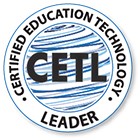How do you know if your school system is high performing in its use of technology? What are your strengths and weaknesses? While there are many free, self-assessments, how do you get a rigorous, outside expert assessment?
 A first step is for districts to learn about CoSN’s new Digital Leap Success Matrix (Matrix) which outlines the practices needed to be a successful digital school system. And, CoSN has created a new fee-for-service CoSN Peer Review process using this Matrix to determine how a district aligns to best practices by expert external peers.
A first step is for districts to learn about CoSN’s new Digital Leap Success Matrix (Matrix) which outlines the practices needed to be a successful digital school system. And, CoSN has created a new fee-for-service CoSN Peer Review process using this Matrix to determine how a district aligns to best practices by expert external peers.
The Matrix focuses primarily on ten key areas: Leadership & Vision, Strategic Planning, Ethics and Policies, Instructional Focus & Professional Development, Team Building and Staffing, Stakeholder Focus, Infrastructure, Information and Data Management, Communications Management, and Business Management.
1. Leadership and Vision: This component sets the tone for the entire transformation. On the inspirational side, the vision that is developed becomes the “true north” by which all policies, procedures, and operationalized innovation are guided. If this vision gets to the heart of improving outcomes for students, the transformation will be pointed in the right direction. If the vision is limited to bringing in technology solely for engagement or to connect with the digital generation, the transformation will likely go astray. In addition to vision, there are many programmatic necessities such as distributed collaborative leadership, data-informed decision making, continual improvement processes, and equity practices.
2. Strategic Planning: The principles of program management apply to the process of strategic planning including setting goals and identifying success metrics, aligning resources, and planning for technology implementation. Key is ensuring that instructional goals precede technological goals.
3. Ethics and Policies: Policies operationalize the vision. They will either help or hinder innovation and transformation and must be crafted with care. They include everything from legal compliance to responsible use policies to student data privacy policies, and much more.
4. Instructional Focus and Professional Development: Supported by standardized processes, infrastructure, and policies, this area is one where ongoing innovation and improvement is core. On the “inspiration” side, instructional practice is evolved by adapting (not adopting) successful practices from the field, engaging in thoughtful action research, and focusing on practices that support students taking ownership of their learning and environments that support the activation of intrinsic motivation. On the “perspiration” side, using data to inform teaching and personalize learning as well as having a formal ongoing improvement process support the development of innovative practices. In addition, there is a need to address the “elephant in the room” of teaching to the test. Systems theory says that when one subsystem (test scores) is optimized, the system as a whole becomes suboptimal. To keep a focus on test scores from driving out other important learning outcomes, it is important to intentionally focus on success skills such as creativity, critical thinking, collaboration, and communication and content knowledge simultaneously.
5. Team Building and Staffing: New processes require cross-functional organizational structures where obsolete functions are no longer supported. A transformational environment also requires that teachers and staff model the behaviors and skills that they are asking students to learn. As one desired outcome is for students to take ownership of their learning, teachers must demonstrate taking ownership of their teaching (and administrators of their work, and so on). This calls for an environment that supports intrinsic motivation: one that offers autonomy, mastery, and purpose as opposed to one with a top-down command-and-control structure. Intrinsically motivated teams are at the heart of transformed schools – they are the ones who say, “I could never go back to the old way of teaching.”
(Next page: 5 more key areas for digital readiness)
6. Stakeholder Focus: Transformation doesn’t happen in a vacuum – it is critical to nurture community partnerships as well as to seek, and act on, feedback from parents, students, teachers, and other stakeholders.
7. Infrastructure: Transformed teaching requires robust, scalable, reliable networks based on open industry standards. It is not unusual for transformed environments to see 60% year over year growth in bandwidth capacity demand and a network that can’t keep up with that escalation. The inability to keep up with demand can cripple the transformation in teaching that can occur with the digital leap.
8. Information Management: The district needs to implement and maintain high quality data systems for data integration, security, privacy protection, data reporting, standardized assessments, and IT management.
9. Communications Management: Modern districts use web technologies and social networks as part of communicating both internally and externally and these need to be thoughtfully managed to set the correct tone and send a consistent message. In fact, transforming districts need to explicitly market themselves to their communities, naming and branding their initiative, and providing a compelling rationale.
10. Business Management: All business functions need to be maintained as part of the block-and-tackle of managing a transformed district from road mapping technology evolution to aligning resources, sustainable funding, and developing and measuring Key Performance Indicators.
The Difference between the Matrix and the Framework
 The Matrix is tightly aligned to the CoSN Framework of Essential Skills created in 2012 to assess the skills required of an educational technology leader which is the basis for the Certified Educational Technology Leader or CETL®. The Framework of Essential Skills focuses on ten specific skill areas encompassing the responsibilities and knowledge needed to be a viable education technology leader.
The Matrix is tightly aligned to the CoSN Framework of Essential Skills created in 2012 to assess the skills required of an educational technology leader which is the basis for the Certified Educational Technology Leader or CETL®. The Framework of Essential Skills focuses on ten specific skill areas encompassing the responsibilities and knowledge needed to be a viable education technology leader.
While the Framework focuses on leadership, technology and instructional skills for an individual, the Matrix focuses on technology infrastructure as a building block for school systems to build 21st century instructional practices. A district requires both a highly skilled workforce and a progressive and scalable technology infrastructure to create conditions for success in this new environment.
Harnessing Peer Review
CoSN created the Peer Review to align school district information technology processes and policies with best practices as identified in the Matrix. Steve Langford, Chief Information Officer for the Beaverton School District in Oregon summed up the review process, “Moving through a digital conversion is a complex process, requiring transformation not only from IT, but across the entire school system.
The CoSN Peer Review offering aligns with CoSN’s mission to support school technology leaders with the resources and information they need. Experienced leaders visit and apply their combined knowledge and experiences to assist school districts in assessing their capabilities and planning for a digital conversion.”
The Peer Review represents an honest assessment of a district’s technology capabilities based on data collected from all of the stakeholders in a school district. Reviewers are practicing ed tech leaders from school districts with very similar challenges.
A typical peer review begins with data collection. In advance of a site visit, reviewers will evaluate key planning documents such as policies and procedures, operating plans, strategic plans and organizational charts. Based on this information, a survey document is provided to a large number of faculty and administrative stakeholders in the district. This data allows reviewers to be more efficient in identifying who they need to talk with and what they need to focus on when onsite.
Once onsite, reviewers will interview stakeholders to align their beliefs with best practices identified in the Matrix. A typical visit is completed with two to three days of interviews. While onsite, the review team will meet with technology leadership and cabinet members to provide a preliminary high level assessment of findings. This allows for immediate feedback on recommendations before anything is committed to writing.
A full written report summarizing observations and detailing the team assessment is prepared by the group leader and submitted in draft format to the district within two weeks. These reports have been used by collaborative district teams to plan for resource needs and allow them to craft their custom roadmap toward digital readiness.
Dr. Veronica Garcia, Superintendent of Santa Fe Public Schools in New Mexico had this to say about a recent review, “CoSN’s Peer Review was extremely useful to Santa Fe Public Schools because it gave us high level, externally validated overview on how we are using technology and it tied to the rigorous Digital Leap Success Matrix. It was very timely and provided key recommendations that were realistic, tangible and very much aligned with the realities of our operating environment.”
- 5 ways school districts can create successful community partnerships - November 21, 2024
- Trump picks Linda McMahon to lead, and possibly dismantle, Education Department - November 21, 2024
- 6 ways to create engaging elementary learning spaces - November 20, 2024


